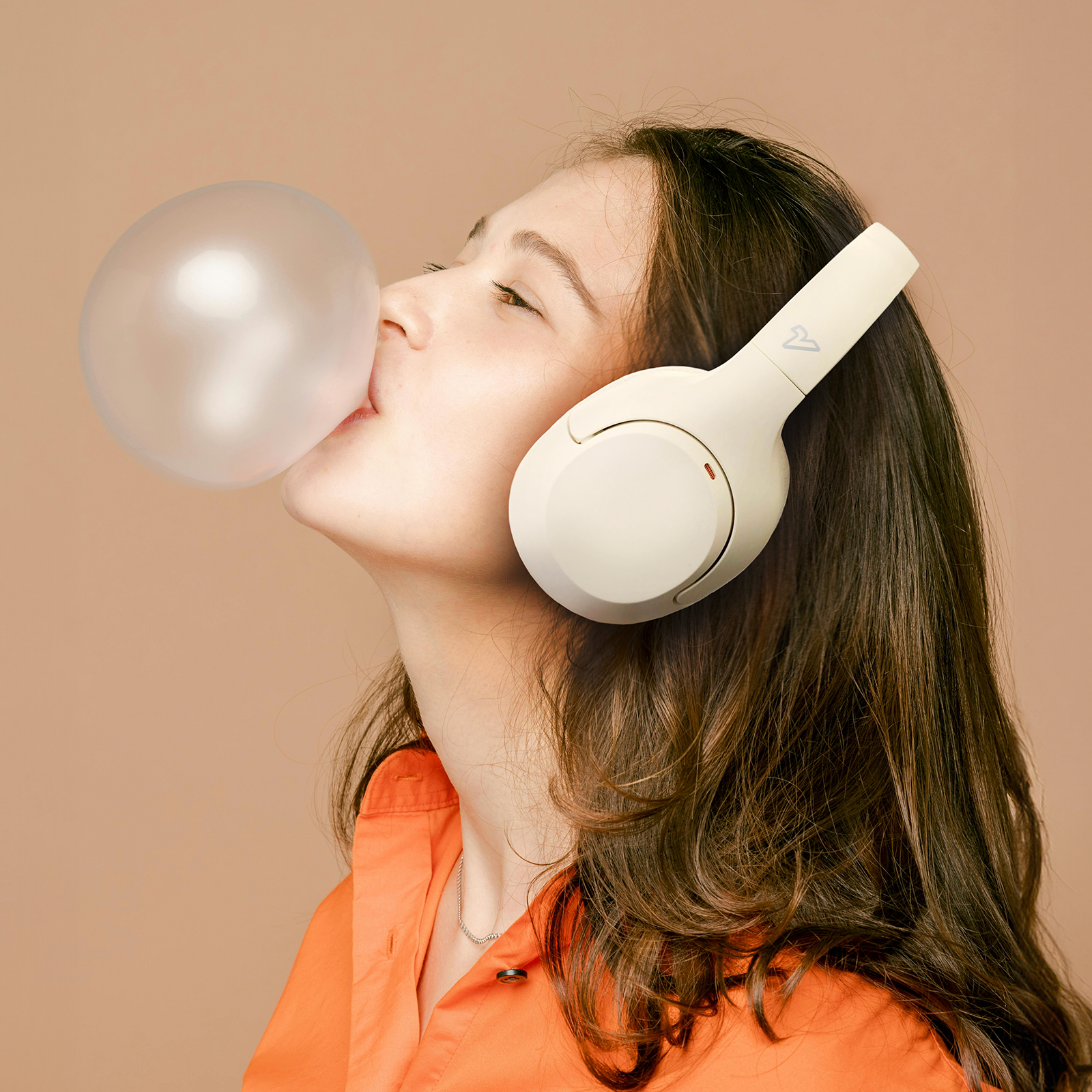Understanding Headphone Specifications: What Really Matters for Sound Quality
Introduction
As a headphone enthusiast who has spent countless hours testing various models, I've noticed a common challenge among consumers: deciphering the technical specifications that manufacturers prominently display on their packaging. From frequency response to impedance, these numbers can seem like a foreign language to many. But which specifications actually impact your listening experience, and which are simply marketing jargon?
This guide aims to demystify headphone specifications, focusing on the metrics that genuinely influence sound quality. Whether you're a casual listener or an aspiring audiophile, understanding these key factors will empower you to make informed purchasing decisions that match your unique listening preferences.

The immersive experience of quality headphone listening in a comfortable environment
The Essential Specifications That Impact Sound Quality
Frequency Response: The Range of Sound
Frequency response, typically expressed as a range like "20Hz - 20kHz," represents the spectrum of sound frequencies your headphones can reproduce. Human hearing generally spans from 20Hz (deep bass) to 20kHz (high treble), though our sensitivity to these extremes diminishes with age.
Extended Frequency Ranges and Hi-Res Audio:
You may notice some premium headphones advertising extended frequency ranges like "20Hz - 40kHz," which exceeds the limits of human hearing. These expanded ranges are often associated with Hi-Res Audio certification, such as the Japan Audio Society (JAS) Hi-Res standard, which requires headphones to reproduce frequencies up to at least 40kHz.
What This Means For You:
While humans cannot directly hear frequencies above 20kHz, some audiophiles and researchers suggest these ultrasonic frequencies may affect the perception of sound in subtle ways, potentially adding a sense of "airiness" or contributing to the overall sound character. Additionally, having headphone drivers capable of reproducing these extended frequencies often indicates higher-quality construction that may perform better within the audible range as well.
For the average listener, the Hi-Res certification provides assurance that the headphones meet certain quality standards and will likely perform well with high-resolution audio files (24-bit/96kHz or better). However, to benefit from these capabilities, you'll need:
- Hi-Res certified audio sources (lossless files like FLAC or high-quality streaming services)
- A compatible DAC (Digital-to-Analog Converter) capable of processing higher sample rates
- Music recorded and mastered to take advantage of this expanded range
Remember that a wider frequency range doesn't automatically translate to better sound quality. What matters more is how evenly your headphones reproduce frequencies across the spectrum. Headphones with a "flat" or neutral frequency response will deliver sound closer to the artist's original intent, while others might emphasize certain frequencies (like bass) for a more colorful presentation.
Impedance: Matching Your Headphones to Your Devices
Measured in ohms (Ω), impedance indicates the electrical resistance of your headphones. This specification ranges from low (16Ω) to high (600Ω+) and directly impacts how your headphones interact with audio sources.
What It Means For You:
Low-impedance headphones (below 32Ω) work efficiently with portable devices like smartphones and tablets, requiring minimal power to produce adequate volume. High-impedance models (100Ω+) typically demand dedicated amplification to reach their full potential.

Wireless headphones offer convenience for on-the-go listening with smartphones and tablets
Matching impedance correctly is crucial for optimal sound quality. Using high-impedance headphones with underpowered sources can result in insufficient volume and thin sound, while pairing low-impedance headphones with powerful amplifiers might cause distortion at higher volumes.
Sensitivity: How Loud Your Headphones Can Get
Sensitivity (measured in dB/mW) indicates how efficiently headphones convert electrical power into sound. Higher sensitivity means louder volume from the same power input.
What It Means For You:
Headphones with higher sensitivity (around 100dB/mW or more) can reach satisfying volume levels even with low-powered devices like smartphones. This specification works hand-in-hand with impedance to determine how your headphones perform with different audio sources.
For everyday listening on portable devices, headphones with higher sensitivity and lower impedance offer the most convenient experience. However, audiophiles using dedicated amplifiers might prefer less sensitive, higher-impedance models that can handle more power without distortion.
Driver Size and Type: The Sound-Producing Element
The driver is the component that converts electrical signals into sound waves. Common types include dynamic, planar magnetic, and electrostatic, each with distinct sound characteristics.
What It Means For You:
Contrary to popular belief, larger drivers don't necessarily produce better sound. What matters more is the driver technology and implementation. Dynamic drivers excel at producing punchy bass, while planar magnetic drivers often deliver exceptional clarity and detail.
Your choice should align with your listening preferences and practical needs:
- Dynamic drivers: Common in portable headphones, offering good all-around performance
- Planar magnetic: Typically found in premium open-back headphones, providing exceptional detail and spaciousness
- Electrostatic: Reserved for high-end audiophile systems, offering unparalleled transparency but requiring specialized amplification
Beyond the Numbers: Subjective Factors That Matter
Soundstage and Imaging
Soundstage refers to the perceived spatial dimensions of the sound, while imaging describes how accurately instruments and vocals are positioned within that space.
What It Means For You:
These qualities aren't captured in specifications but significantly impact your listening experience. Open-back headphones typically offer wider soundstage than closed-back models, creating a more speaker-like experience. Exceptional imaging allows you to pinpoint the location of instruments in complex recordings, enhancing immersion.
For classical music, jazz, and acoustic recordings, good soundstage and imaging can transform your listening experience from merely hearing music to feeling present at the performance.
Tonal Balance
Tonal balance describes how evenly headphones represent different frequency ranges in relation to each other.
What It Means For You:
Well-balanced headphones reproduce bass, midrange, and treble in proper proportion, without any range overpowering the others. This balance ensures vocals remain clear, instruments sound natural, and bass provides foundation without muddying the overall presentation.
Your personal preference plays a significant role here. Some listeners prefer a "V-shaped" sound signature with emphasized bass and treble, while others favor midrange focus that highlights vocals and acoustic instruments.
Overrated Specifications: Marketing vs. Reality
Total Harmonic Distortion (THD)
While THD measures unwanted frequency alterations in sound reproduction, most modern headphones achieve THD levels below human perception thresholds.
What It Means For You:
Unless THD exceeds 1% (which is rare in quality headphones), differences are virtually inaudible. Don't be swayed by marketing emphasizing minute THD differences – other factors will have a much greater impact on your listening experience.
Maximum Input Power
This specification indicates the maximum power headphones can handle without damage, often highlighted for gaming headsets and DJ headphones.
What It Means For You:
For typical listening, even at high volumes, you'll rarely approach these limits. This specification becomes relevant only for professional applications where headphones might be driven at extreme levels for extended periods.
Resolution Claims Beyond Audibility
Manufacturers may advertise support for extremely high sample rates (up to 384kHz) or bit depths (32-bit), far exceeding what's necessary for human perception.
What It Means For You:
While Hi-Res Audio (24-bit/96kHz) offers benefits over standard CD quality (16-bit/44.1kHz), the improvements become increasingly subtle beyond this point. Rather than focusing on maximum supported resolution, consider whether the headphones can reproduce the nuances present in well-recorded music at reasonable resolutions.
How to Evaluate Headphones Beyond Specifications
Critical Listening
Specifications provide useful context, but nothing replaces personal listening experiences. When possible, test headphones with familiar music that spans different genres and recording qualities.
What to Listen For:
- Detail retrieval: Can you hear subtle elements like finger movements on guitar strings or breath intakes by vocalists?
- Bass quality: Is the bass tight and textured, or boomy and overwhelming?
- Vocal presence: Do voices sound natural and properly positioned in the mix?
- Fatigue factors: Do high frequencies cause discomfort during extended listening?
Comfort and Build Quality
Even the best-sounding headphones become useless if they're uncomfortable for your head shape or if they break prematurely.
What to Consider:
- Weight distribution: How do they feel after 30+ minutes of wear?
- Clamping force: Do they cause pressure points around your ears?
- Materials: Do ear pads create a proper seal without causing heat buildup?
- Durability: Are hinges, cables, and other potential failure points well-constructed?
Making Informed Decisions Based on Your Needs
Matching Headphones to Your Listening Environment
Different environments demand different headphone characteristics:
- Commuting/travel: Consider closed-back designs with good isolation and moderate impedance/high sensitivity for mobile device compatibility
- Home listening: Open-back headphones might provide superior soundstage for critical listening in quiet environments
- Professional use: Prioritize accuracy, comfort for extended wear, and durability
Compatible Equipment Considerations
The full potential of your headphones depends on your audio chain:

A dedicated headphone setup with proper amplification can unlock the full potential of high-quality headphones
- Source quality: Even exceptional headphones can't compensate for poor-quality audio files
- Amplification: High-impedance headphones require dedicated amplification
- Digital-to-analog conversion: External DACs can improve sound quality from digital sources, especially for Hi-Res audio
Hi-Res Audio: Worth the Investment?
For those considering Hi-Res certified headphones with extended frequency response, here's a practical assessment:
Who Will Benefit:
- Listeners with access to Hi-Res audio sources and appropriate playback equipment
- Those who can detect subtle differences in audio quality and value these nuances
- Audiophiles seeking the most accurate reproduction of high-quality recordings
Who Might Not Notice the Difference:
- Casual listeners primarily using compressed streaming services like standard Spotify
- Those listening in noisy environments where subtle details are masked
- Consumers using basic smartphones or computers as their primary audio source
The best approach is viewing Hi-Res capability as a potential bonus rather than an essential feature. Focus first on finding headphones with sound characteristics you enjoy, comfortable design, and compatibility with your existing equipment.
Conclusion
While headphone specifications provide valuable information, they tell only part of the story. The best approach combines understanding these technical aspects with critical listening and consideration of your specific needs.
Remember that the "best" headphones aren't necessarily those with the most impressive specifications or the highest frequency range, but rather those that deliver the sound signature you enjoy, comfortably, within your budget, and compatible with your listening setup.
Whether you're seeking the analytical precision of reference headphones or the energetic thump of bass-forward models, understanding what these specifications truly mean empowers you to cut through marketing hype and find headphones that will bring you lasting musical enjoyment.



Share:
Best Headphones for Every Workout: Gym, Yoga, Running & More
Solving the 5 Most Common Bluetooth Headphone Connection Problems